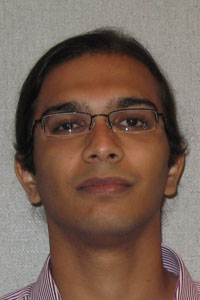Alex Sincore wins 2017-2018 CREOL Student of the Year Award
Alex Sincore is the winner of the 2017-2018 CREOL Student of the Year Award. The CREOL Student of the Year Award is a program to recognize the outstanding academic, scientific and professional achievements of graduate students in CREOL.
 Alex Sincore "2 µm Fiber Lasers: Power scaling concepts and challenges" Alex Sincore "2 µm Fiber Lasers: Power scaling concepts and challenges"
Fiber lasers have experienced explosive growth in the past decades, with 1 µm Ytterbium- doped lasers holding >13 % of the laser market. Fiber lasers operating at longer wavelengths, specifically 2 µm Thulium-doped lasers, are experiencing a similar growth in system performance. However, the power scaling challenges faced at 1 µm are inherently different at 2 µm. The two major limitations are high thermal loads and nonlinear effects. To address the first issue, we propose in-band pumping which substantially reduces the quantum defect. We have demonstrated >90% efficient 2 µm fiber lasers with plans to scale over 100 W. As for nonlinear effects, there is a lack of data identifying which nonlinearities limit 2 µm fiber lasers. We address this by investigating nonlinear thresholds with a variable spectral bandwidth, nanosecond pulsed fiber laser. We determine that stimulated Brillouin scattering limits narrow linewidth 2 µm sources. On the other hand, modulation instability limits broader linewidth 2 µm sources, which is not found at 1 µm. Overall, with this knowledge and proper system design, Thulium-doped fibers can continue to grow and provide high power systems for emerging applications.
Alex Sincore received the B.S. degree in physics from the University of Florida, Gainesville in 2012. He went on to receive his M.S. degree in optics from CREOL, The College of Optics & Photonics at the University of Central Florida, Orlando in 2014. He is currently a Ph.D. candidate in the optics program at CREOL. Since 2012, he has been a graduate research assistant in the Laser Plasma Laboratory. His primary research interests are in designing and developing high-power and high-energy fiber lasers. Additional research interests include applications in material processing and atmospheric propagation, nonlinear effects in optical fibers, and nonlinear frequency conversion to the mid-infrared.
Runners up are Yun-Han Lee and Ashutosh Rao.
 Yun-Han Lee: " Polarization diffractive optical elements for augmented and virtual reality displays" Yun-Han Lee: " Polarization diffractive optical elements for augmented and virtual reality displays"
Polarization diffractive optical elements based on geometric phase exploits the in-plane rotation of liquid crystal (LC) axis to encode the wave-front profile to two-dimensional distribution. This approach enables LC-based ultra-thin high-efficiency grating deflectors and lenses to be electrically switchable. By utilizing this type of switchable lenses and deflectors, we can produce display images with depth content, and enhance the display resolution for virtual reality displays. For augmented reality displays, we also demonstrated a large-angle high-efficiency grating deflector which can be used as a wave-guide coupler.
Yun-Han Lee is currently a PhD student in Prof. Shin-Tson Wu’s research group. He received his Master degree in Physics from National Taiwan University in 2011. His research mainly focus on liquid crystal devices for near-eye display applications. He has published 19 journal papers and 8 conference proceedings.
 Ashutosh Rao: "Thin-film lithium niobate nanophotonics for electro-optics, second- order nonlinear optics, and quantum optics on silicon" Ashutosh Rao: "Thin-film lithium niobate nanophotonics for electro-optics, second- order nonlinear optics, and quantum optics on silicon"
Ion-sliced thin-film lithium niobate (LN) nanophotonics has facilitated the resurgence of integrated photonics based on LN. These thin-film waveguides offer over an order of magnitude improvement in optical confinement and bending radius compared to conventional LN waveguide technology. My talk will focus on utilizing the enhanced optical confinement to form miniaturized and efficient nanophotonic LN devices. These devices include the fastest thin-film LN electro-optic modulators demonstrated to date, two approaches to nonlinear optical frequency conversion, i.e., periodic poling and mode-shape modulation or grating assisted quasi-phase-matching, and photon pair generation for quantum optics in periodically poled nanophotonic LN.
Ashutosh Rao is a PhD student in Dr. Fathpour's Integrated Photonics Emerging Solutions (IPES) group. His research is focused on nanophotonics in lithium niobate for electro-optics, nonlinear optics, and quantum optics. He has published 10 research articles (6 as the primary author) including 2 invited review articles, and over 16 articles in international conference proceedings, including 1 invited talk.
Posted Tuesday, February 6, 2018
|